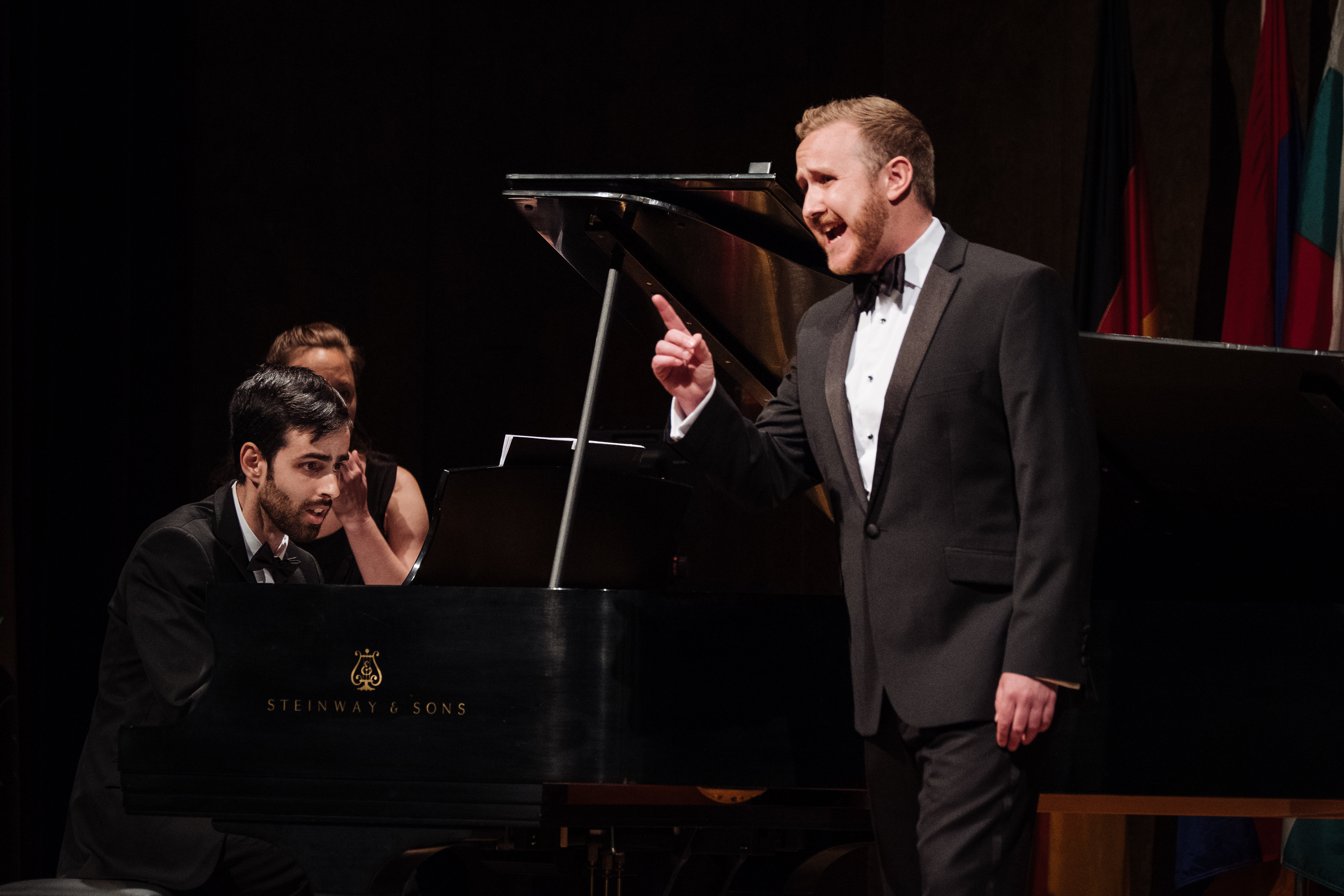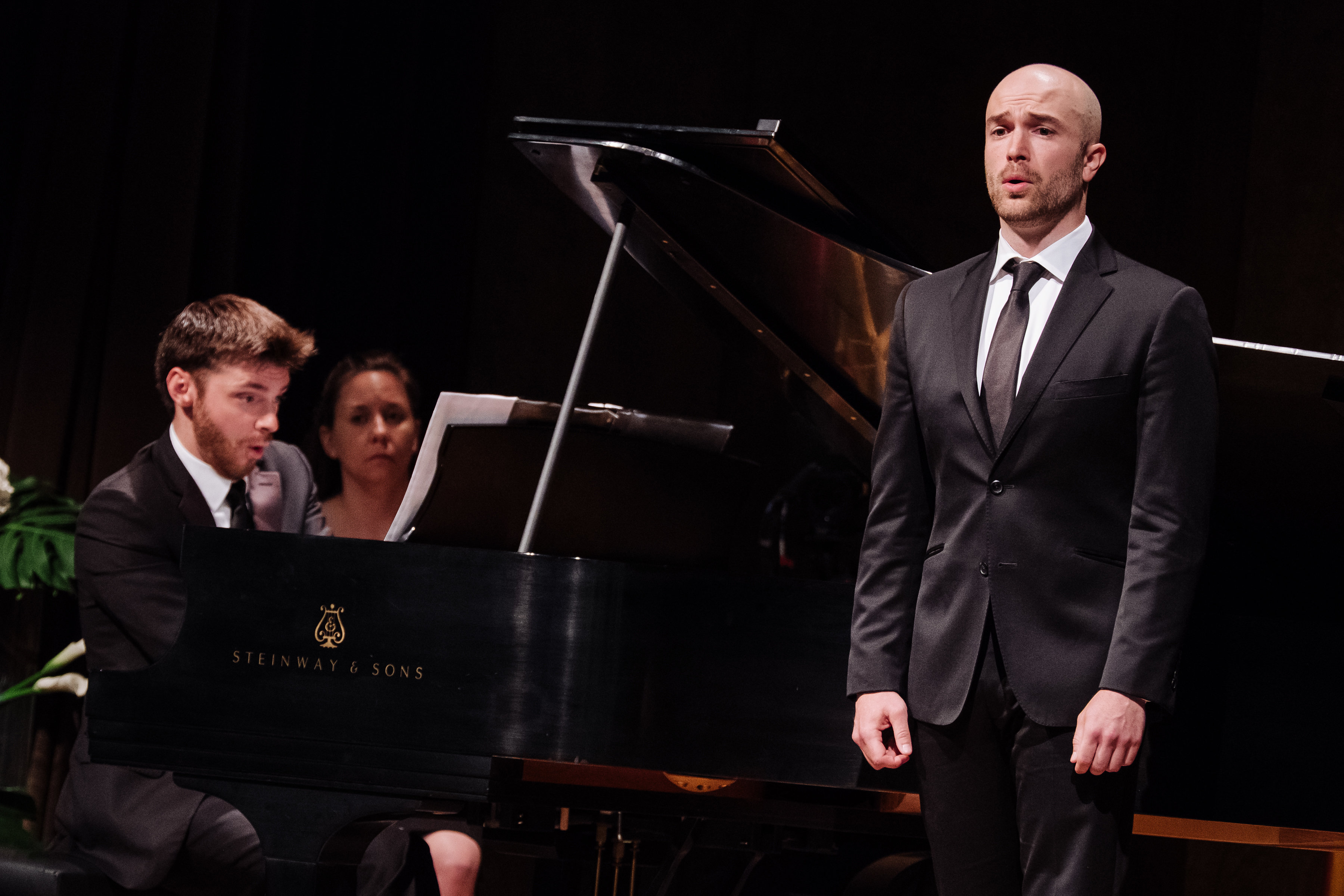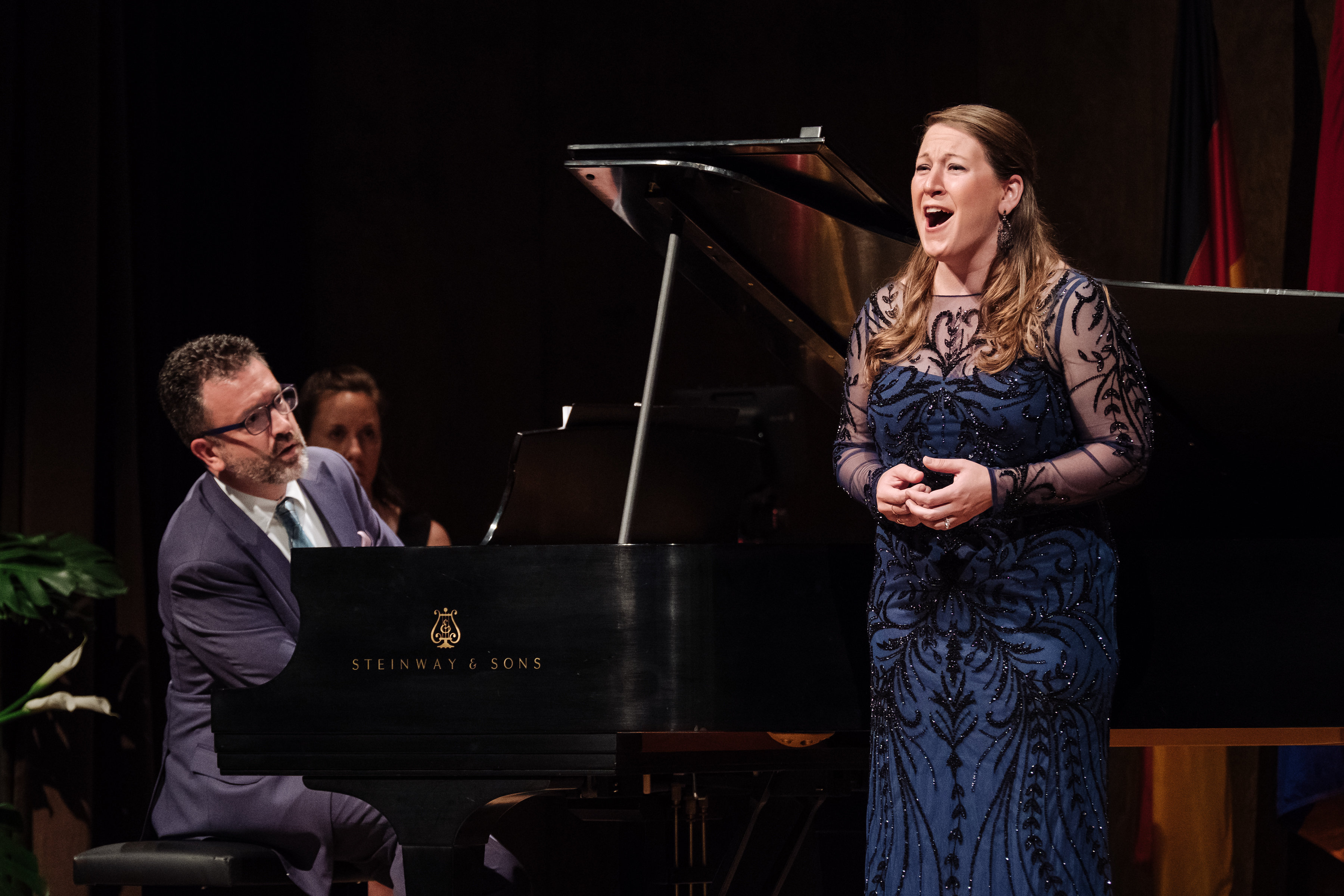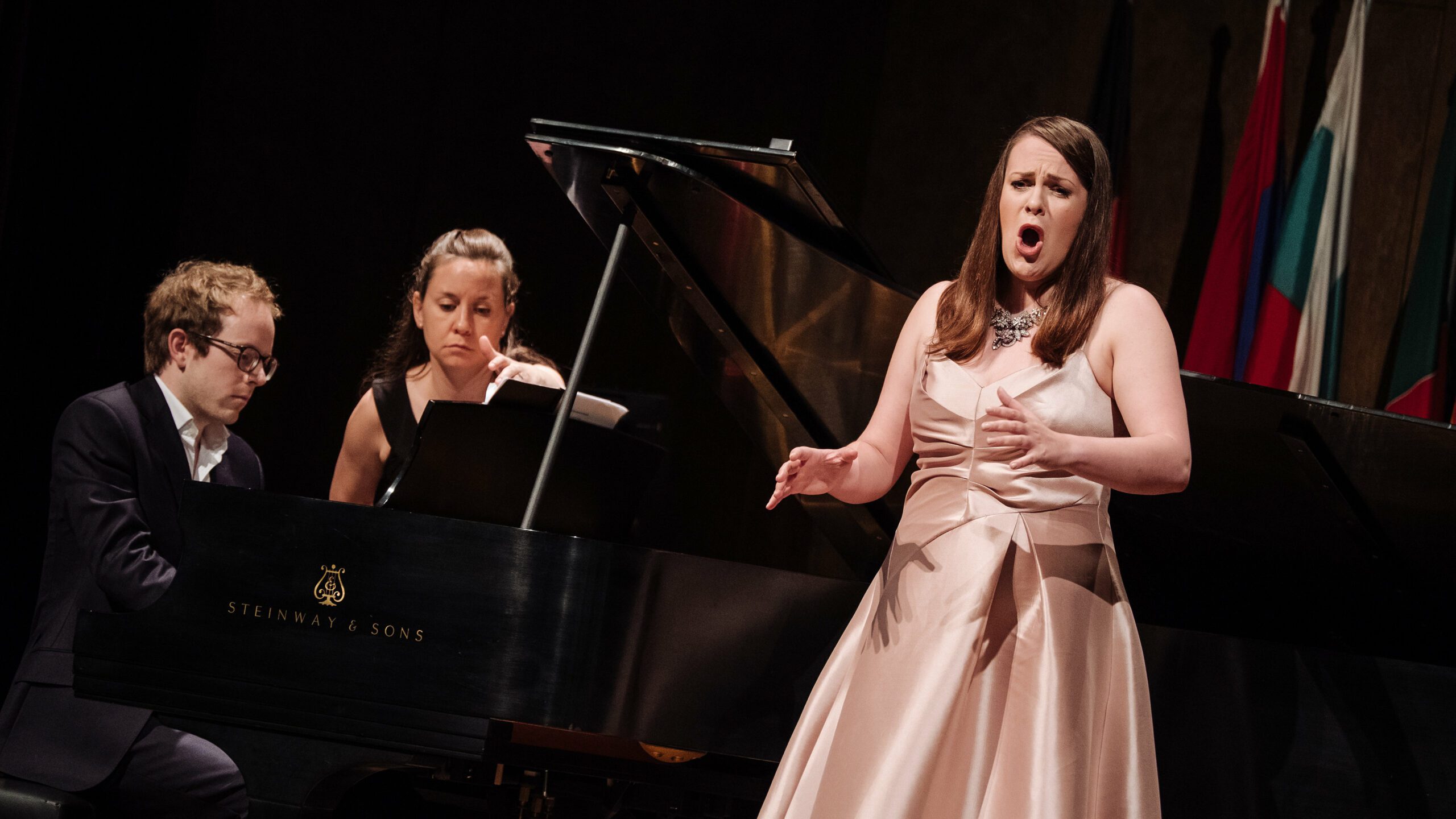At this stage, the elements that distinguish one performance as ‘better’ than another are extremely subtle. Did one singer’s French vowels sound more ‘authentic’ than another’s? Did the pianissimo that soprano X decided to throw in at the end of her German lied sound affected, or was it merited by the text? Were the bass’s programming choices too unvaried? You get the picture. The four singers heard today are all at the top of their game and each could probably take first prize depending on which way the wind is blowing.

João Araújo (piano) and Julien van Mellaerts (baritone) in the Art Song division finals, CMIM, 2018. Photo: Tam Lan Truong Photography
Julien van Mellaerts takes risks at CMIM
First up was New Zealand baritone Julien van Mellaerts. His opening song, Richard Strauss’s “Traum durch die Dämmerung,” showed off his technical mastery of terraced dynamics, building from a hushed half voice whisper to bright, hall-filling climaxes. He is a risk-taker—so much so that in Schumann’s famous “Mondnacht” (anyone who knows Barbra Streisand’s ‘Classical’ album will recognize it) he wasn’t afraid to slip into falsetto on a couple of particularly high, exposed tones. His program was carefully balanced to switch from the reverie of the Schumann to the more outgoing ‘aren’t those Parisian women hot?’ of Debussy’s “Ballade des femmes de Paris” which ended the program. Van Mellaerts’ forte singing shows off an appealing, bright tone to contrast his expert use of ‘voix mixte’ (incorporation of heady/falsetto-y and chest tone). If one were to quibble, his English and French diction weren’t entirely clear, at least in this warm acoustic. French vowels were less than idiomatic. Pianist João Araújo proved an equal partner, obviously relishing his part in creating the drama, always in close communication with the singer.
Gemma Summerfield: sublime communicator at CMIM
Among Gemma Summerfield’s many attributes, her French diction in two Debussy selections (the amusingly rhyming “Green” and “Spleen”) was exemplary. Every word was clear…not always easy for high sopranos to achieve. But the British soprano offered so much more than schoolbook diction. Everything she sang emerged from a place of genuine emotion. Her opening set of Sibelius songs included one of the most devastatingly dramatic of all art songs—“Flickan kom ifrån sin älsklings mote” (“The girl returned from meeting her lover”), in which a young woman experiences her first amorous betrayal—was delivered with intense feeling and like all of her set, stunningly beautiful tone. With so much to admire, it’s very difficult to pick out the highlights. For me, her delivery of Roger Quilter’s Seven Elizabethan Lyrics probably best demonstrated what makes Summerfield so special: clear communication of text (tricky given the opacity of much Elizabethan poetic symbolism); a jaw-dropping mastery of vocal technique especially in the area of dynamic variation and, consistent beauty of tone. All of these qualities reached a peak in her closing Strauss lieder including an intensely-felt “Ruhe, meine Seele” (“Rest my soul”) dispatched with huge contrasts from soft to loud; perfect legato (smooth singing line from note to note) and pianist Sebastian Wybrew’s incredibly sensitive pianism at the end of the song.

Peter Dugan (piano) and John Brancy (baritone) in the Art Song division finals, CMIM, 2018. Photo: Tam Lan Truong Photography
John Brancy: baritone with tenorial aspirations!
American art song duo, baritone John Brancy and pianist Peter Dugan are a well-known quantity on the international singing competition circuit. In fact, Brancy won third prize at the 2012 CMIM and more recently placed second at the 2017 Wigmore Hall International Competition; was first in the 2015 Jensen Foundation Vocal Competition and was the 2013 winner of the Marilyn Horne Song Competition. His program today was extremely varied and polished. He opened with one of the most ecstatic of all English Art Songs, “To Gratiana Dancing and Singing”, like Summerfield’s Quilter, based on Elizabeth poetry. Its climatic phrases should only be attempted by baritones with the most secure of upper ranges which Brancy clearly possesses. His very tenorial high notes were scattered liberally throughout, including an (unwritten?) interpolated, blazing tone at the end of his last song, Rachmaninov’s explosive paean to nature, “Vesennié vody” (“Spring waters”). Brancy knows exactly how to communicate mood through body language: every gesture, glance and smile telegraph the feeling he wishes to create. This is mirrored by carefully chosen dynamic shadings which his formidable technique allows him to pull off fearlessly. Is it therefore ungrateful to feel that everything is slightly too calculated? This is where we get into the nebulous area of emotional response…which is going to be different for every listener. I admired everything Brancy did today, but was rarely touched emotionally beyond the visceral thrill of the sound he created. But some fellow audience members were moved enough to offer him the only ‘standing O’ of the afternoon.

Olivier Godin (piano) and Clara Osowski (mezzo-soprano) in the Art Song division finals, CMIM, 2018. Photo: Tam Lan Truong Photography
Clara Osowski offers moving tribute to Maureen Forrester
The final singer was American mezzo-soprano Clara Osowski, accompanied by hard-working ‘house pianist’ Olivier Godin. Osowski possesses a classic, burnished mezzo tone, absolutely even throughout its range as well as a refined stage presence. Some of the internet chatter (what, me read gossipy online chatter about singers—no!) earlier in the week complained she lacks dynamism and that her repertoire choices included a surfeit of languorous selections. Compared to an extrovert like Brancy, Osowski is much less obvious in how she tells her stories. But to this ear and eye, she offers an equally, if not more, compelling alternative. Like Summerfield, she is able to evince emotion simply and directly through her music-making. She may lack the dynamic range of a van Mellaerts or Brancy, but her more direct approach pays off. For example, the simply-etched, almost vibrato-less, ‘Ah’ vocalise at the end of Berlioz’s “La mort d’Ophelie” perfectly captured Shakespeare’s haunted, manic pixie. Whether she had it in mind or not, her choice of selections from Robert Fleming’s song cycle, The Confession Stone—which chronicles the life of Jesus through the eyes of his Mother—has a strong connection with Montreal native, and iconic Canadian contralto, Maureen Forrester who premiered the work in 1968. Osowski was at her best in the cycle’s “Bring me those needles, Martha” in which Mary uses knitting to futilely distract herself from Christ’s impending crucifixion. Subtle gesture, darting glances and pinpoint diction conveyed the unbearable tragedy. And perhaps as a dig to the naysayers, she ended with Virgil Thomson’s “A Prayer to St. Catherine” in which the singer prays for a cure to her heartache and shyness. Osowski seemed to be letting the audience in on something very personal here, which is the aim of all great song recitalists.
Because it’s fun to do, and this is a competition after all, here are my prize-winning choices (like you couldn’t tell): 1. Gemma Summerfield 2. Clara Osowksi 3. John Brancy 4. Julien van Mellaerts. Also, in addition to the song prizes, there is a special $10,000 John Newmark prize for pianists which on evidence of his subtle responsiveness and sheer enjoyment I’d give to João Araújo. We’ll have to wait until Thursday night for the results however—that’s when all the (many) prizes will be handed out after the Aria section finals.
Tomorrow (Monday) night is the first of the Aria semi-finals including Canadians, mezzo-soprano Emily D’Angelo and tenor Andrew Haji.











